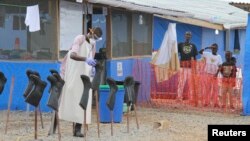At the height of the Ebola epidemic, aid groups couldn’t build Ebola treatment units, or ETUs, fast enough to isolate patients. Now, with the epidemic showing signs of ebbing, some ETUs in Guinea, Liberia and Sierra Leone are sitting empty, their futures uncertain. Can they be maintained or repurposed?
“I think the short answer is there is no plan,” said Damien Queally, deputy regional director of programs for Plan International, a child-centered global development group.
“There’s a lot of discussion going on at the government level around what should be done with these centers," he said. "From [our] perspective, we see it as an opportunity to reinforce the whole primary health care services in the country … especially the community care centers, where there are structures available that can support midwifery or other potential epidemic illnesses, like Lassa fever, TB, leprosy or anything contagious."
But Queally said many units are quite large and would be expensive to maintain. Some people may also be afraid to go to a former Ebola treatment unit, no matter how many times it has been cleaned.
Some are mere tents
Other ETUs weren’t built to last. They are tented structures made of plastic sheeting. The chlorine solution used to disinfect them is quite corrosive.
The Liberian government has started decommissioning its once-brimming ETUs in the capital, Monrovia, and surrounding Montserrado county.
Doctors Without Borders downsized its ETU in Monrovia from 250 beds to 60. It was the largest ETU ever built.
But this outbreak isn’t over, said Sean Casey, regional director for Ebola response at the International Medical Corps.
"The reality now in West Africa is that Ebola exists in the animal population and there’s still active transmission happening … so it’s important that we still have Ebola treatment units as long as there are active cases, and then beyond that," Casey said.
The epidemic began in Guinea in late 2013. Ebola began to surge in Liberia and Sierra Leone in June. Global response didn’t really ramp up until September, as images of sick Liberians dying in the streets hit the international media. But it took time to construct ETUs, and some were only recently completed, even as the need was dropping off sharply.
Some have criticized this as wasteful. Aid workers disagree.
Tariq Riebl, Oxfam’s humanitarian program manager for Ebola response in Liberia, said that "no one has ever seen an epidemic of this proportion. … No one was fully expecting the surge of cases ... but also no one predicted the descent, which has been far more rapid than any of us would have hoped for. So of course there was an excess capacity now because of the lag time it takes to put things in place."
Value seen in training
Over the course of the outbreak, thousands of people in the affected countries have been trained in Ebola patient care, safe burials and sanitation. Experts said those human resources are the most important to preserve.
"It’s important that they maintain that level of training and refresher training on an annual or biannual basis to ensure the health staff remember the safety protocol," Plan International’s Queally said.
The hope is that these countries will never again need ETUs with hundreds of beds each and that reaction to future outbreaks will be swift and effective.







